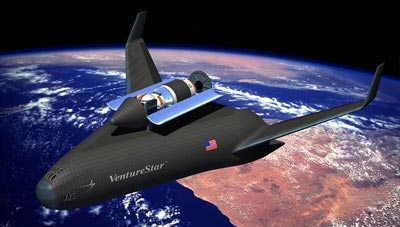Orphan RLVsby Taylor Dinerman
|
| The RLV industry, which was so important just a few years ago, is in deep trouble. |
The EELVs (Evolved Expendable Launch Vehicles) are absorbing most of the DoD’s attention and investment. The Atlas 5 and Delta 4 families have, so far, earned themselves a remarkable record for reliability and safety. In the process they have taken the steam out of any urgent push for a new generation of lower cost and more reliable rockets. Both vehicles are expensive and both require extensive ground support, but they are the proverbial “bird in the hand”. Even with decent funding and lots of luck a new militarily-useful RLV is more than a decade away.
RLV development has, since the late 1980s, been associated with the question of space weapons, in particular the deployment of space-based boost-phase interceptors, such as Brilliant Pebbles. It seems that for the moment the administration is backing away from a fight on this subject. That such a fight will some day have to happen is almost inevitable, but someone has made the decision that the US would be better off waiting. The wisdom of this decision can be questioned, but its effect on the near term need for an RLV is all too real.
If some day America were to suffer a “space Pearl Harbor”, to use the expression from the 2001 Rumsfeld commission report, the need for RLVs will be very real. The rapid reconstitution of the US military and intelligence satellite fleet will be the number one national priority after such an attack. Everything would be thrown into the effort, but there would be bottlenecks, including the ability to build new satellites. The greatest weakness, however, would be the ability to launch replacements fast enough.
To prepare for such a scenario the US military might be able to stockpile both fully manufactured satellites—such as those in the GPS constellation—and put together a supply of essential long lead components for larger satellites such as the Milstar communications spacecraft. Even if they also warehoused launch vehicles or their components, like engines, setting up, checking out, and actually getting these off the ground would take months or years to get 50 to 100 satellites—the number that could need to be replaced after a major attack—into orbit. Four RLVs that could launch once a week could get 48 satellites into orbit in three months.
Of course, these would not be the large types of military spacecraft we now have in orbit. No RLV in the next 20 years is going to be able to launch more than three or four tons at best. That would not be an obstacle if the Pentagon were to concentrate on building a fleet of smaller craft optimized for launching on such vehicles.
The chances of such an RLV emerging from the normal DoD procurement process within the next fifteen to twenty years are almost nil. Since NASA is not going to do it that leaves the private sector: Elon Musk, Burt Rutan, Jim Benson, and a few people like them. Which opens up this question: can a suborbital vehicle, such as SpaceShipOne, be the basis for something that will actually get into orbit? Say, SpaceShipFifteen?
| RLVs are going to be needed by the US government at sometime within the next twenty years, if not by the military then by NASA. With tight resources, the government is going to have to look at innovative ways to nurture this strategic industry. |
Aside from providing help with regulations and possibly insurance, can the government do anything else to help? Not with any large-scale, multibillion-dollar development contracts, which would probably be more than these firms could handle right now or even in the near future. Smaller technology development contracts integrated with a step-by-step business plan would be far more useful. A low-cost technology insertion program that would give these firms access to components made by the large DoD contractors at reasonable prices would be another way to help them achieve their goals. Even better would be a way to provide tax credits under the Calvert-Ortiz plan. (See “Earth-to-orbit transport: the missing ingredient in Bush’s space policy recipe”, The Space Review, February 2, 2004).
RLVs are going to be needed by the US government at sometime within the next twenty years, if not by the military then by NASA. With tight resources, the government is going to have to look at innovative ways to nurture this strategic industry. Keeping a balance between the “beans and bullets” needs of the troops in Iraq , Afghanistan, and elsewhere, and the urgent need to maintain America’s military technological supremacy is not going to be easy. However, that’s their job, and that is one of the things they will be judged on.
